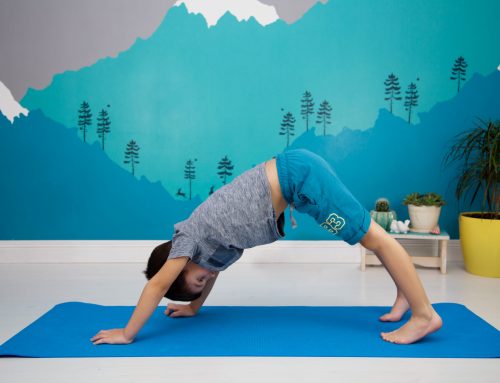
There’s evidence galore that implementing classroom movement is a good thing. Kids get the wiggles out, yes. But new research has also shown that a little bit of movement throughout the day helps kids learn better. The benefits are countless! Kids who move throughout the school day are able to concentrate longer, focus harder and remember more.
So, with all of this evidence that in-class movement is a good thing, why aren’t more teachers joining this movement? We asked a bunch of teachers why and they shared their reasons with us. Then, we asked former third grade teacher and the CEO of Classrooms in Motion, Dr. Hildi Nicksic, to tell us how teachers can overcome those barriers so that every classroom can get moving.
Issue #1: Core Subjects Take Up So Much Time
“I am under immense pressure to focus on core academic subjects like math, reading and science. In fact, the teachers in my district are being evaluated on their students’ standardized test scores. So I have no choice but to make core subjects my top priority. My principal has begun emphasizing ‘time on task’ as proof of performance. Therefore, I have to keep a log of the time my kids spend focusing on academic core subjects. Because of this, I just don’t feel that taking valuable class time for movement can be justified.” —M.K., third grade teacher
The Fix: Learn the Benefits of Classroom Movement
While core subjects certainly do take priority, when you look at the research on classroom movement, it becomes clear that there is another side to the story. There are actually many benefits of classroom movement—yes, even on core academic performance—that often outweigh the loss of seat time.
For example, there is evidence that replacing just a few minutes per hour of seat time with movement does not have a negative impact on academic performance. In fact, one study (Erwin, Fedewa and Ahn, 2013) shows that students who participated in daily physical activity breaks not only had significantly higher fluency scores in both reading and math but higher averages on standardized math and reading tests as well.
Physical activity breaks also have a positive effect on attention and behavior. One study (Donnelly and Lambourne, 2011) examined the effect of activity breaks on attention. After one hour of regular cognitive school tasks, students who were given a 15-minute physical activity break of moderate intensity scored significantly higher on selective attention tasks. Basically, if you give them movement breaks, they will be able to pay attention for longer when you are doing core tasks.
Physical activity can also be beneficial as a strategy for increasing student classroom on-task behavior. One study (Herman, Beer and Morton, 2013) showed that regularly structured physical activity breaks resulted in significantly fewer individual and group disciplinary corrections. This meant that students were able to spend more seat time focusing on core subjects after spending a few minutes out of their seats.
Issue #2: There’s Just No Time to Plan!

“I’m busy. Like really busy. During the school year, I often work 50 to 70 hours every week, with a large part of that being planning, curating, honing and developing my lesson plans and classroom activities. With Core prioritization, not to mention constant pressures of updating to current technology, it’s hard to find time to fit in one more thing, even if that thing is important.” —R.J., seventh grade teacher
The Fix: Don’t Plan!
The last thing you need as a teacher is one more thing to plan. So don’t! Instead, come up with a list of classroom movement activities that you can easily incorporate into your lesson and daily activities. Post that list on the wall, and make sure to implement them for a few minutes every hour. Don’t have time to come up with a list? Visit future blog posts for ideas or add movement using standing desks or active seating so students can move while they learn.
Issue #3: We Just Run Out of Classroom Time!
“I teach high school English, and every period is just jam-packed. The bell rings and we start with reading a passage. Then we have discussions and assignments and writing practice, and before I can even glance at the clock, the bell is ringing and class is over. I haven’t even had time to grab a sip of coffee, much less add classroom movement into our daily routine. We just don’t have time for physical activity.” —S.J., 10th grade teacher
The Fix: Write It Into the Lessons
It seems counterproductive to stop the flow of a lesson to do classroom movement, but just the opposite is true: It’s very productive. Just like you probably can’t sit at a desk and grade papers for hours on end, your students probably get a bit tired (and inattentive) after a long lesson or assignment. By taking a few minutes to move, your students will be able to reset their brains and it will result in more attentive learning.
We recommend writing movement into your lesson plans just like you probably already add warm-up activities, discussion time and silent work time into your plans. Before silent reading, have kids get up and do 10 jumping jacks. Implement stations so kids have to get up and move from table to table. Find some movement-based curricular games, like Active Academics Scramble or Run for the Money. It doesn’t take much movement to make a big difference.
You can also add movement into other parts of the day. For instance, you could have a movement station in a corner of your classroom. If students finish early, they can go there and do a silent callisthenic activity such as sit-ups or push-ups. When your class is moving through the hall (space providing), have them do arm circles, triceps kickbacks, lunges, high knees, bicep curls, etc. When you transition between subjects, do a 5-minute exercise video or dance to one of the many kid-friendly videos out there of popular songs.
Issue #4: Physical Education Isn’t My Specialty
“I have absolutely zero, zilch, nada, none training in P.E. and health education. I was a band kid in high school, and I know so little about exercise that I can barely find my way to the water fountain at the gym. OK, I’m exaggerating. I have no problem finding the water fountain, but it’s sure hard to find the weight room. That said, I have no idea how to help my kids exercise and exercise correctly.” —C.M. 6th grade teacher
The Fix: Just Do It

Thankfully, this isn’t Spanish class where you need to know a whole language to teach it. And it’s certainly not computer programming where you could infect your entire school with a nasty virus if you didn’t know what you were doing! Classroom movement is just … moving.
So, first things first, don’t worry about not knowing what to do. In the words of Nike, just do it.
That said, if you want to know more about how to effectively implement classroom movement, you can get yourself up to speed in just a little bit of time. Do a bit of research over the summer so you are ready for the school year. Have a master list of activities available and ready to grab. Create a poster for the kids to have easy reference. Have a central location for materials you might use, such as silks, activity dice, stretchy bands and so on. Make sure your favorite classroom movement websites and video sources are bookmarked on your computer so you can quickly pull them up. Do a little bit of at-home preparation and let the movement flow!
Issue #5: What if My Classroom Dissolves Into a Puddle of Crazy?!
“OK, I’m just going to say it: I teach first grade. If I give them an inch to wiggle, they take a mile. I can just imagine myself watching with growing horror as the fun, happy classroom activities that I so carefully plan dissolve into utter out-of-control chaos. My darling students—love them as I may—just don’t always have a firm grasp on the boundary between fun and Crazyville. How do I know that classroom movement won’t throw them over the line?” —S.W., first grade teacher
The Fix: Lay Down the Law
The key here is to set classroom movement time up. Just like you would any other subject: It’s not a break from the day. It’s not fun time. It’s part of the school day just like math time and reading time and lunch time. And thus, the behavior expectations are exactly the same as they would be for any other classroom activity.
This is absolutely the time to do some front-loading with your class to establish clear expectations of behavior and participation, as well as clear consequences for not using the time constructively. It is imperative to provide structured, teacher-led movement that can be easily adapted for students of all abilities and comfort levels. It’s also such a great opportunity to emphasize the importance of physical activity as part of a healthy lifestyle. Once students understand that this time is an important part of the school day and not designed to be a free-for-all, it will become an activity that is not only productive for learning but a fun time that they look forward to.
Issue #6: Exercise? Do I Have To?
“I have a little confession: I’m not a superpower athlete. I don’t run marathons on the weekends and I don’t go to the gym before school. And between the lesson planning, team meetings, professional development, paper-grading, classroom organizing and, oh yeah, the teaching, I limp to the end of each school day with barely enough energy to flop on the couch and work the remote. How can I tell my kids to exercise when I don’t do it myself?” —D.M., ninth grade teacher
The Fix: You Got to Move It, Move It!
Even if you’re not exactly the poster child for fitness yourself, you can still be a role model. Research shows that teacher fitness level does not affect classroom movement (that’s good news, right?). Even if you are sitting at your desk barking commands at them while they do jumping jacks, your students will benefit.
But hey, we have another idea! If you join in too, you’ll check off one more thing on your should-do list and get healthier to boot! Taking the time to schedule movement for your students reminds you to make physical activity a priority in your life. You can cultivate a “we’re in this together” mind-set in your classroom. Plus, you can bet students will appreciate seeing that physical activity is beneficial for people of all shapes, sizes and ability levels.





Leave A Comment